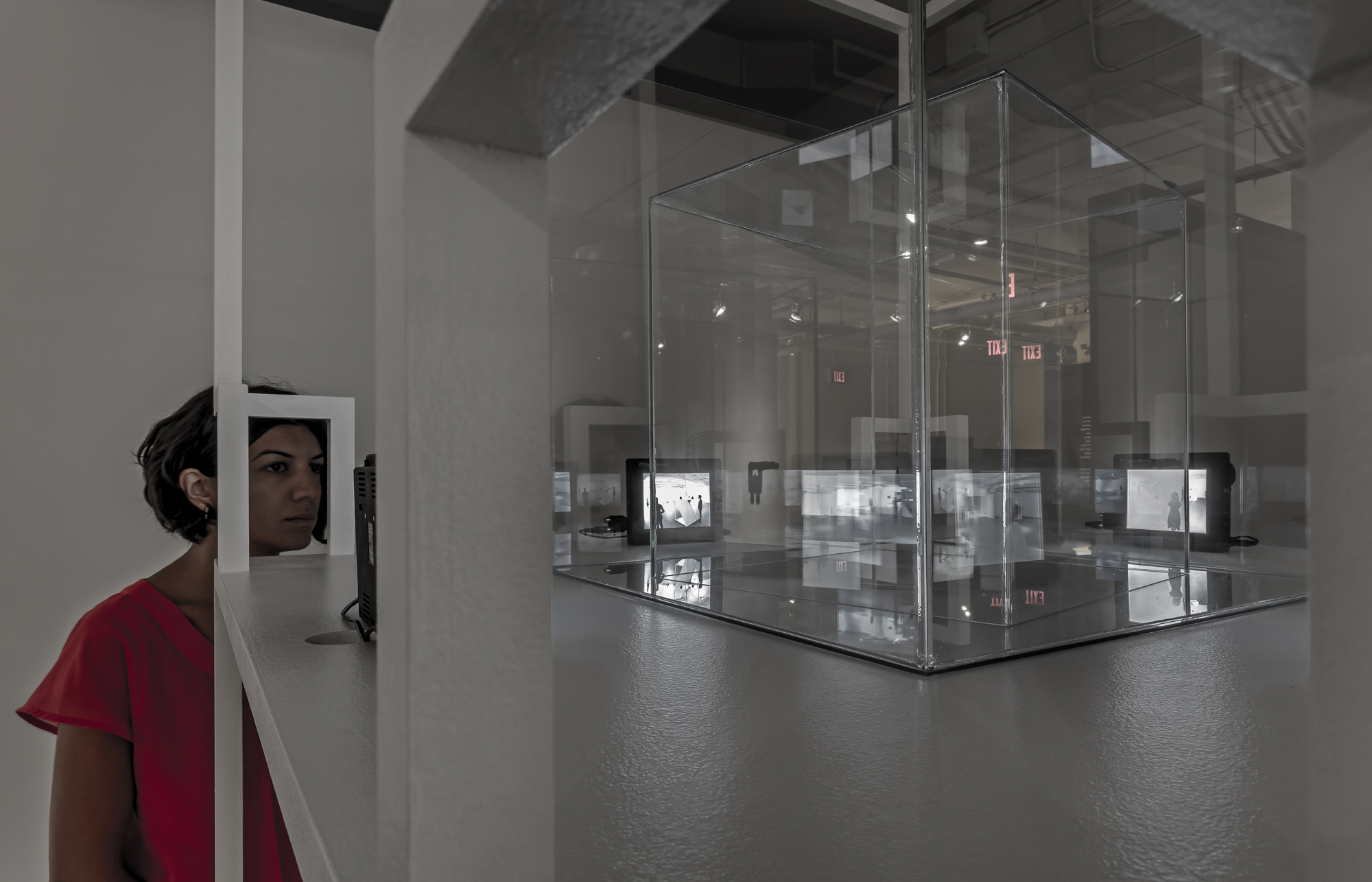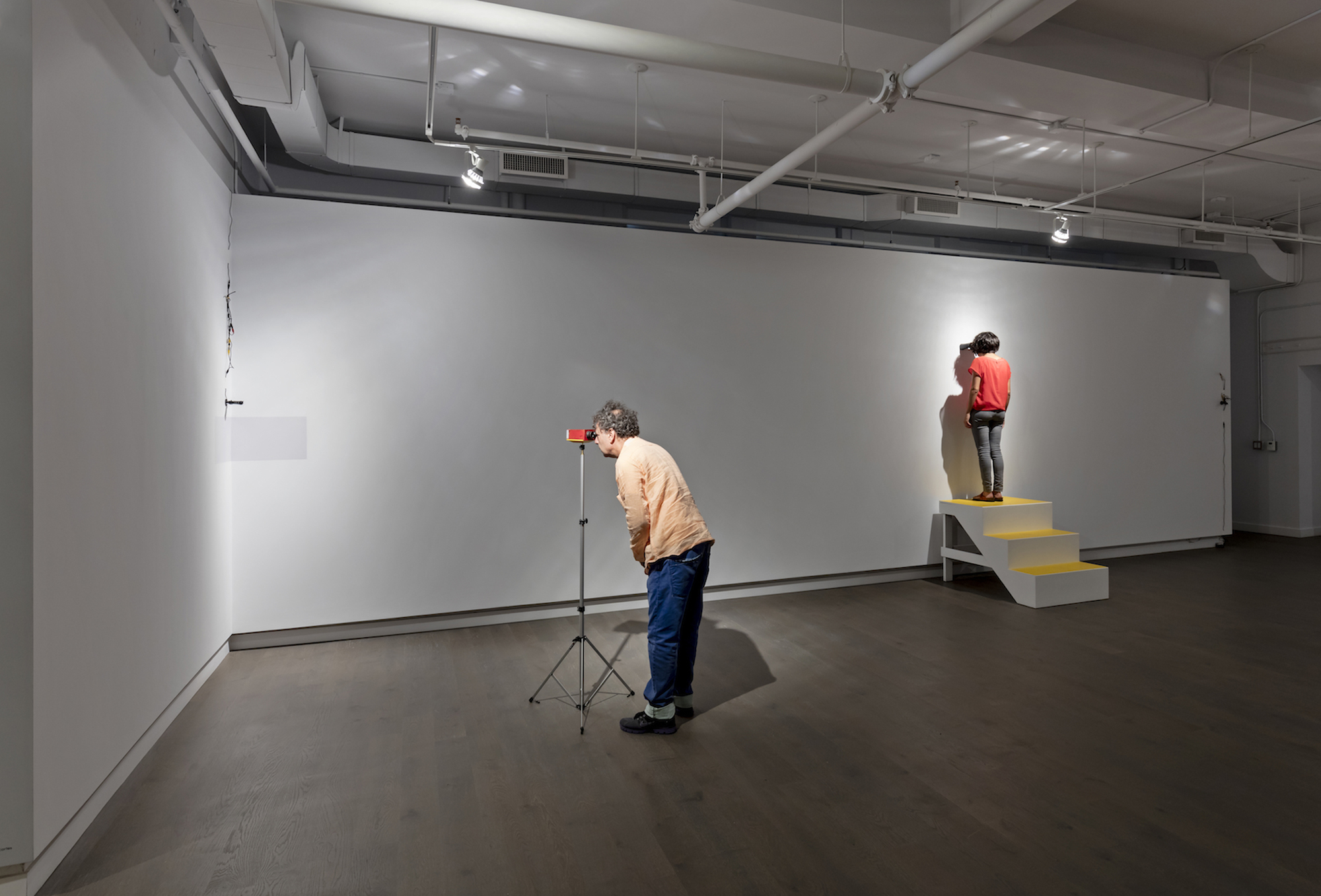ALEXANDER PILIS
ARCHITECTURE PARALLAX: THROUGH THE LOOKING GLASS


Exhibition
Koffler Gallery, 2015
Photo documentation by Toni Hafkenscheid
Based in Montreal, Brazilian-Canadian artist Alexander Pilis investigates the nature of visual perception and the sensory ways of understanding architecture. Taking as guiding principle the notion of parallax – the apparent displacement of an observed object due to a change in the observer’s position – Pilis argues for a methodology of spatial exploration that dislocates the monocular point of view and embraces difference and anarchy of perspective. For this exhibition, he develops a series of minimalist yet playful installations that dismantle the Modernist Western-European models of thought regarding projection, distance, movement and reflection.

In anyeverything, cameras located within the gallery broadcast four live views of the space to monitors positioned to further reflect into the surfaces of two nested glass cubes. The optical structure virtually re-assembles the entire gallery space along with its visitors and their movements, offering an all-encompassing view.
Emulating early theatrical devices that relied on manipulating light and reflection, (dis)appearing enables a significant display – Duchamp’s chess set – to mysteriously materialize and vanish in front of our eyes. Further referencing the game’s strategic choreography, step of two comprises a microscope with a circular convex mirror, a specimen and a glass slide, assembled as an instrument that reveals the gesture of a pawn’s move.
In passe-murailles, two pairs of binoculars inserted within the
South and North walls of the gallery create a collision between outside and inside into the fixed plane of the viewer’s position. Derived from Greek, stereopsis refers to the perception of depth obtained through visual information provided by binocular vision. In ster·e·op·sis, an original stereoscopic device dating from 1914 subverts expectations with a constructed reality. Offered to scrutiny is the very chamber of the viewfinder where two inserted stainless steel spheres create an illusory space. The stereoscope faces a corner where two enlarged photographs superimpose a reproduction of the perpendicular walls onto the space itself, supplanting the real with a simulacrum.
Ultimately, Pilis’s constructions and viewfinders stage the white cube of the gallery as a perception tool central to the experience of visual art. Employing optical illusions, reflections and shifting points of view, they direct the viewer’s performance as both spectator and actor in the gesture of looking and seeing.
Emulating early theatrical devices that relied on manipulating light and reflection, (dis)appearing enables a significant display – Duchamp’s chess set – to mysteriously materialize and vanish in front of our eyes. Further referencing the game’s strategic choreography, step of two comprises a microscope with a circular convex mirror, a specimen and a glass slide, assembled as an instrument that reveals the gesture of a pawn’s move.
In passe-murailles, two pairs of binoculars inserted within the
South and North walls of the gallery create a collision between outside and inside into the fixed plane of the viewer’s position. Derived from Greek, stereopsis refers to the perception of depth obtained through visual information provided by binocular vision. In ster·e·op·sis, an original stereoscopic device dating from 1914 subverts expectations with a constructed reality. Offered to scrutiny is the very chamber of the viewfinder where two inserted stainless steel spheres create an illusory space. The stereoscope faces a corner where two enlarged photographs superimpose a reproduction of the perpendicular walls onto the space itself, supplanting the real with a simulacrum.
Ultimately, Pilis’s constructions and viewfinders stage the white cube of the gallery as a perception tool central to the experience of visual art. Employing optical illusions, reflections and shifting points of view, they direct the viewer’s performance as both spectator and actor in the gesture of looking and seeing.













Artist Info
Alexander Pilis was born in Rio de Janeiro, Brazil, and currently lives and works between Montreal and São Paulo. He is an un-disciplined architectural investigator, artist and curator working under the aegis of Architecture Parallax – a methodology that displaces sight as the singular verification of reality. Furthermore, Pilis instigates a multi-media project exploring issues and questions raised by “the blind architect” as a critique of the modernization of vision and the collapse of the depth of field. He is a seasonal professor in the MFA department at Concordia University and was previously Director of the Global Architecture São Paulo Program in the John H. Daniels, Faculty of Architecture, Landscape and Design, University of Toronto. Pilis has exhibited, taught, lectured, delivered workshops and published internationally, in Canada, USA, England, Spain, Germany, Italy and Brazil.

